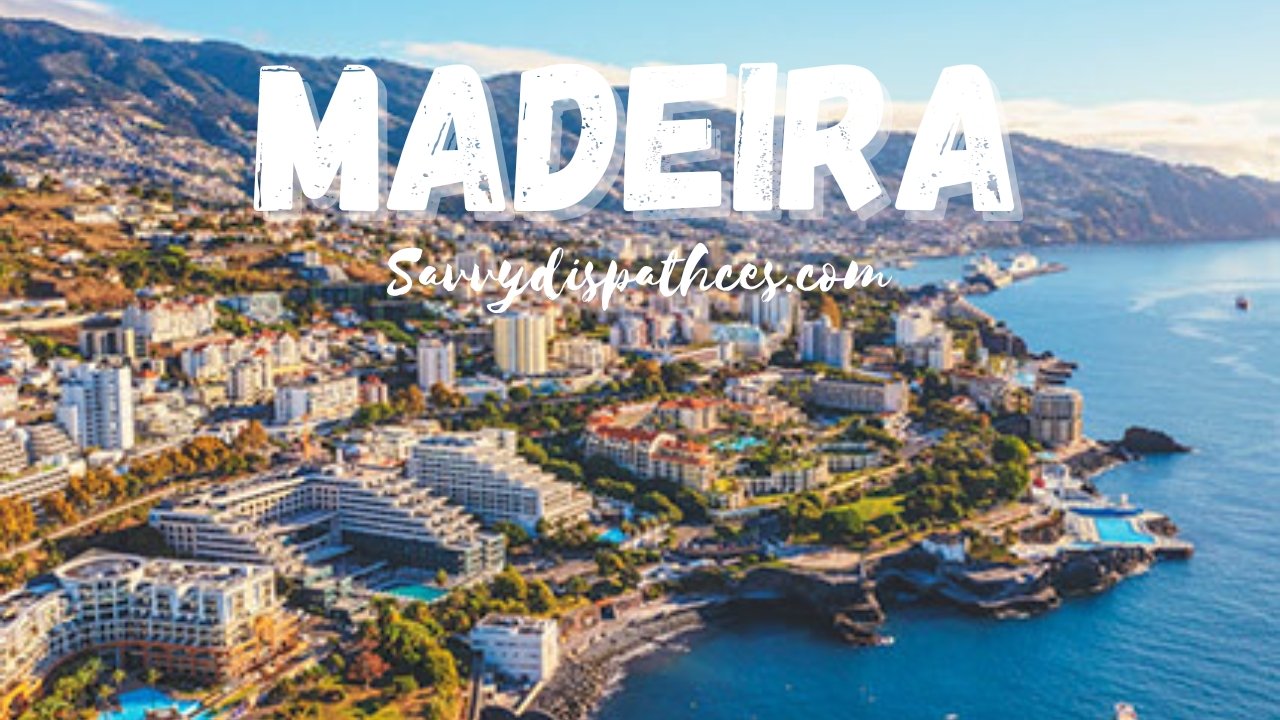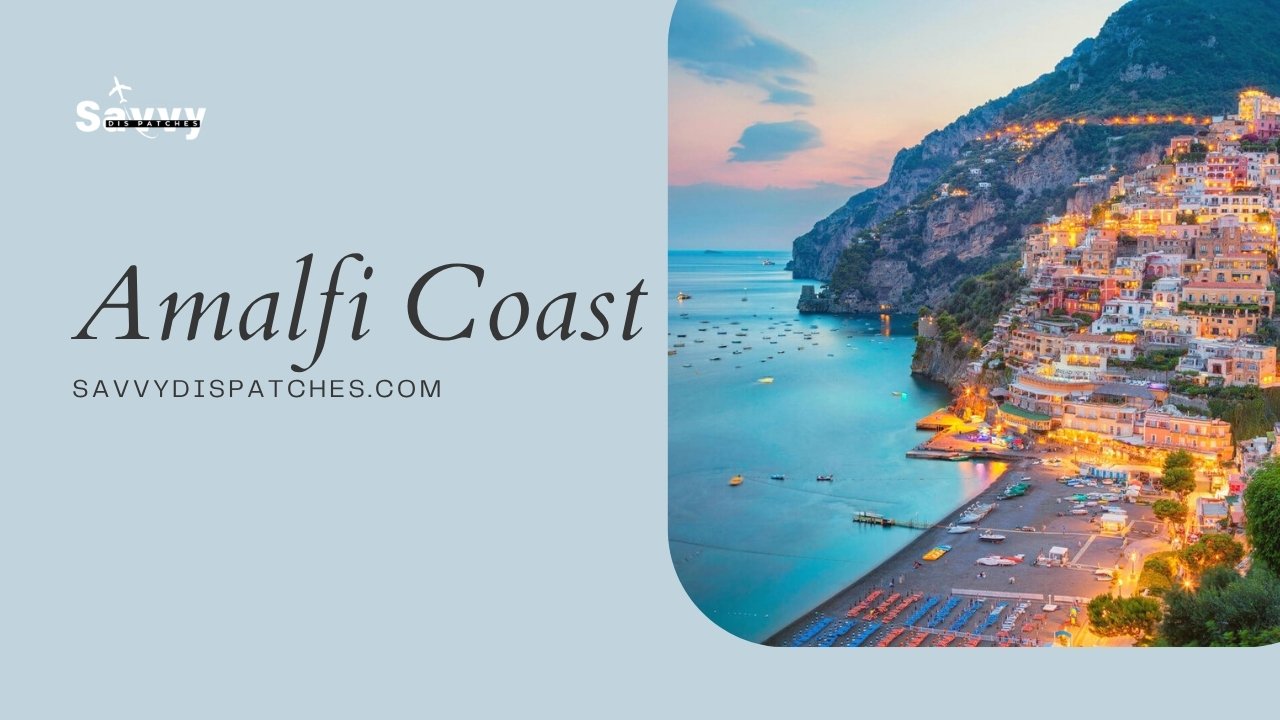Travel
Exploring Port Vila Market
Exploring local food and craft markets is without a doubt one of my favorite activities. Whether it be a little farmer’s market back home in Virginia or the advent markets of Zagreb, markets are the best way to get an instant snapshot of local culture. And, I’ll be totally honest: I really just like gawking at unusual food and/or produce that I’ve never encountered before. Port Vila Market on Efate island in Vanuatu did not disappoint.
Located on the turquoise waterfront of the country’s capital city, Port Vila Market is a fantastic place to spend a few hours. It’s open all day and night, Monday through Friday and half of Saturday. The entire open-air market is divided into three parts: produce stands, mini restaurants, and craft stalls. Luckily for my social anxiety, the craft stalls were the only place where I felt that all too familiar vendor-to-tourist pressure to buy each thing that the vendors pointed out as I passed. In the produce section, though, we were able to leisurely stroll about. We approached nearly every table, picking up fruit, putting it back down… All without any comment from the sellers. It was bliss.
Anyway, without further ado: here is Port Vila Market in photos. (…Psst: If you’re here just because you want to visit the market yourself, scroll down to my “Know Before You Go” section at the very end).

Tropical bouquets for sale outside the craft side of the market.

Big ole dirty cassava roots on display outside the main entance.
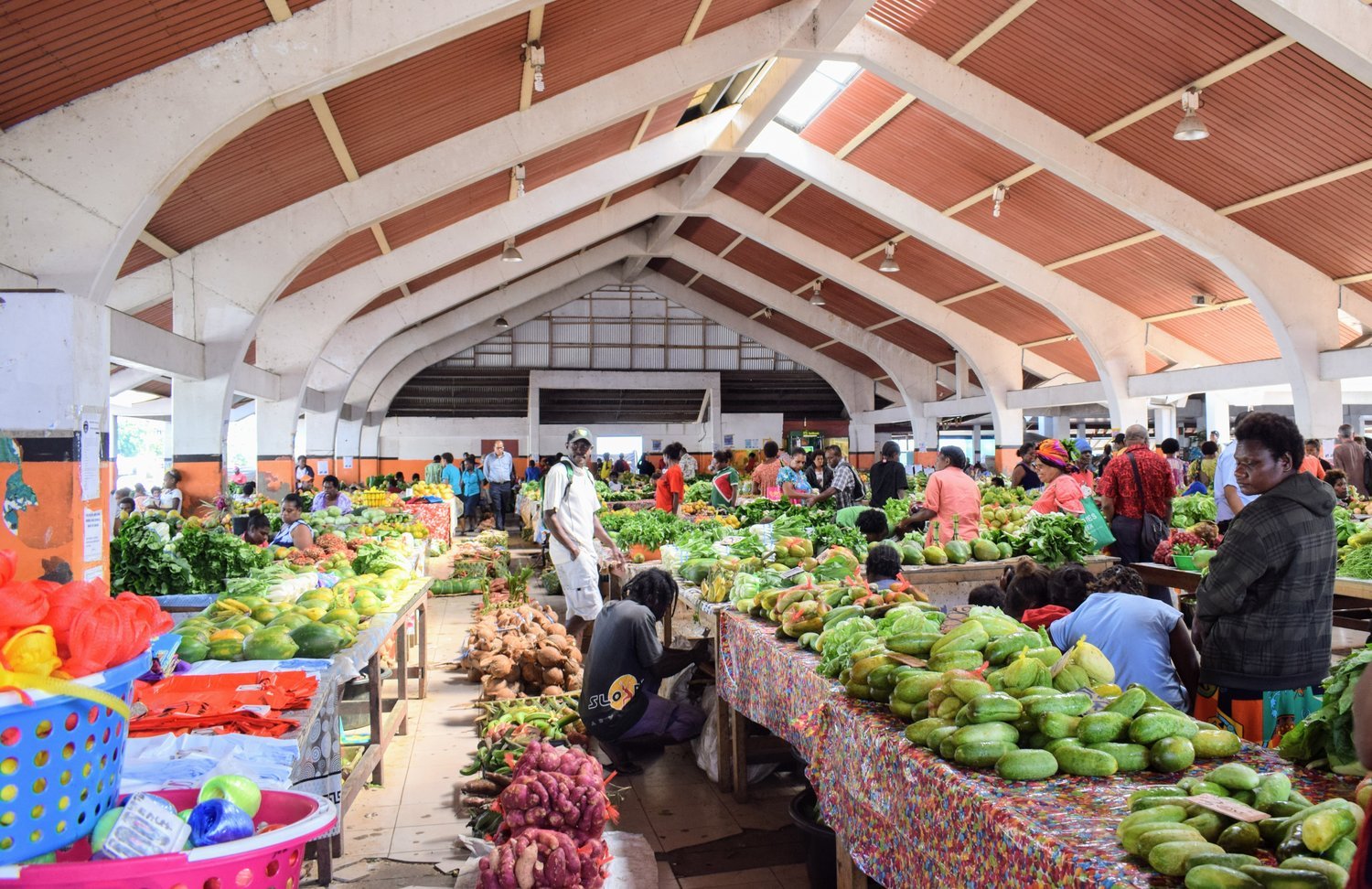
Big ole dirty cassava roots on display outside the main entance.
We entered the market through the produce section, where I was delighted and overwhelmed by the array of food available! The first thing to catch my eye were the beautiful hand-woven banana leaf baskets & wraps that many of the vendors used to store inventory. The second thing was all the items I did not recognize. Some sort of cactus fruit, some pear-shaped vegetables, long gourd-like melons, and… was that cacoa fruit? (Yes it was!) I later found out that the light green pear-shaped vegetables in abundance at the market were choko, also known as chayote. They are a mild-tasting, squash-like veggie that we ate many, many times in stir-fries around Vanuatu. Check them out below on the bottom left going for 200 VT (approx. $2 USD) a bag
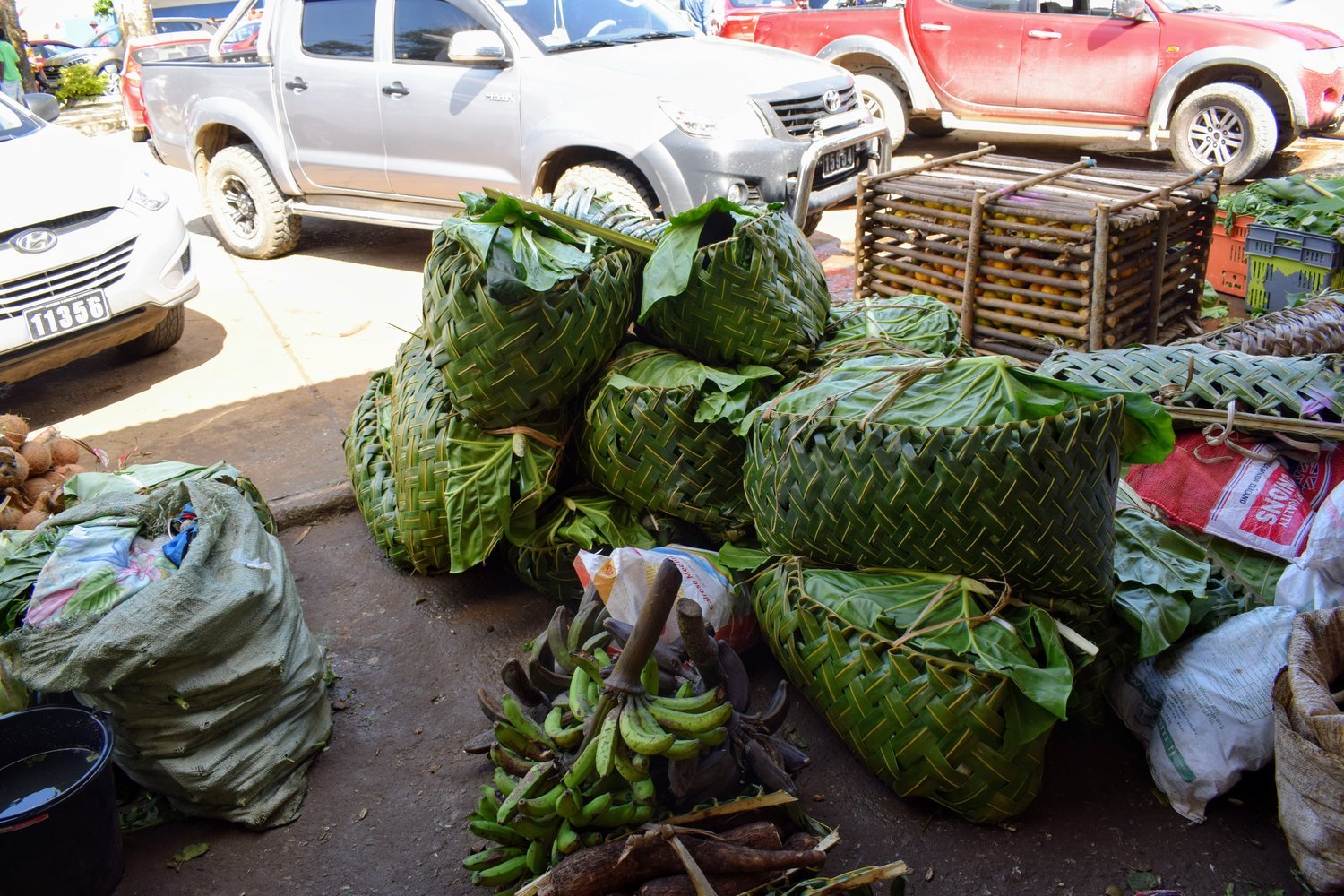
I LOVED the look of these banana leaf baskets
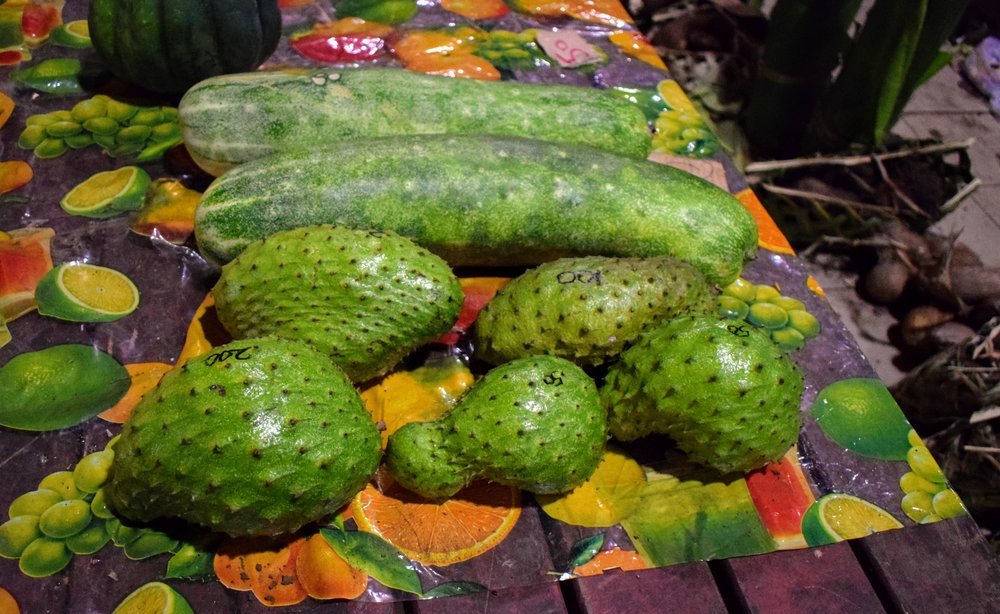
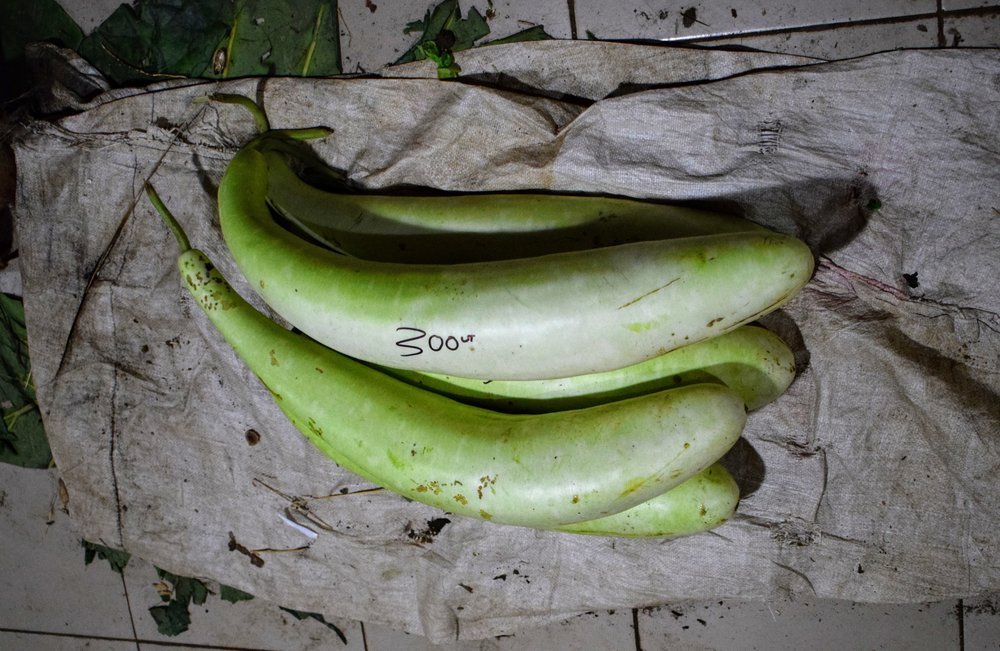

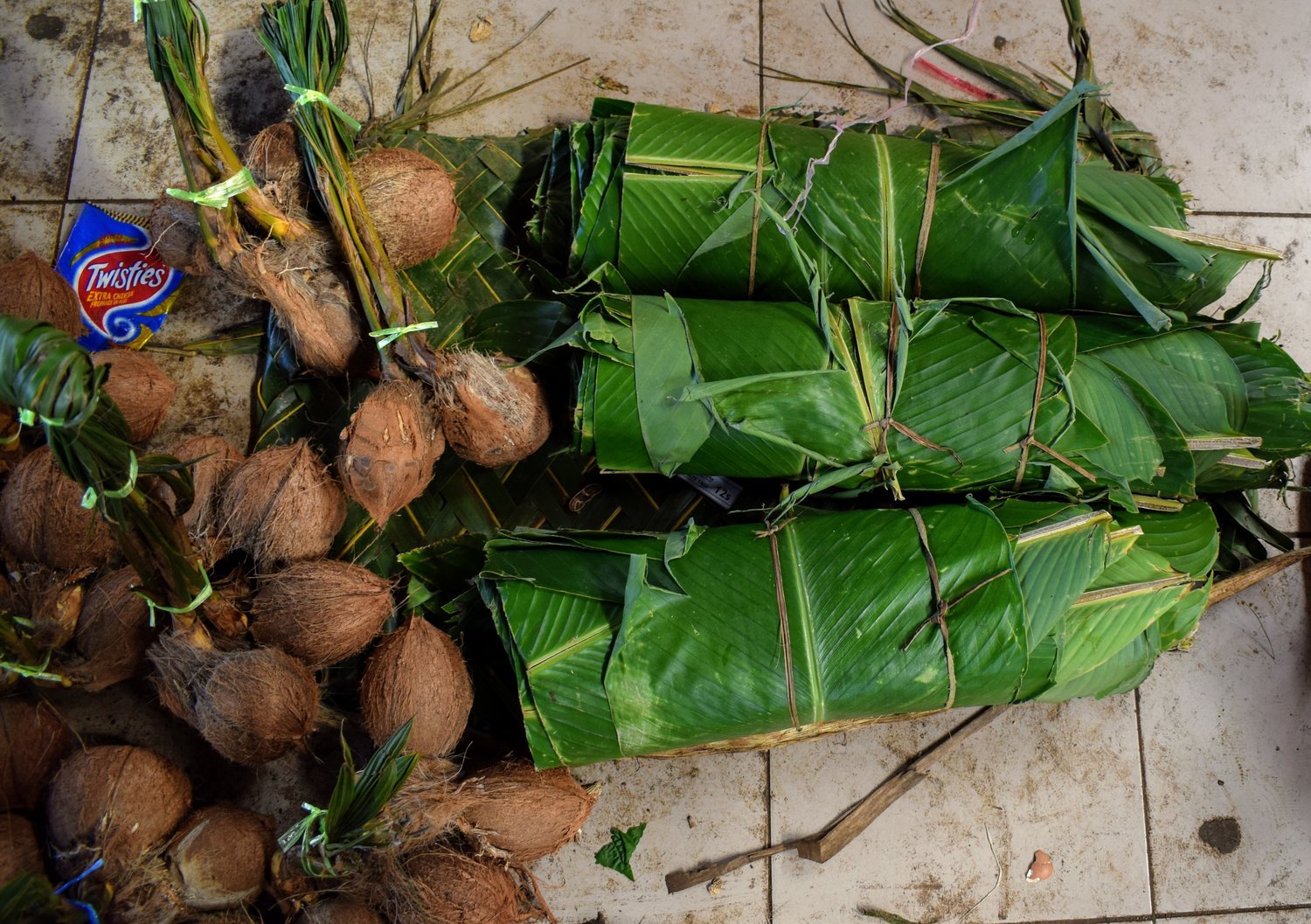
More banana leaves, some coconuts, and… a healthy little bit of dirt & trash.

In between the produce stalls and the craft and clothing alleys of the market is a narrow passageway full of tiny restaurants manned by smiling elderly women. We walked through once to get an idea of which place looked best. Honestly, they all seemed to be offering nearly identical fare. So we sat down at an empty table and ordered a vegetable stirfry, the sole vegetarian cuisine on offer throughout Vanuatu. It was filling and well-cooked but bland. The tastiest part of the meal, honestly, was the tamarind juice we were served out of a dubiously cleaned plastic tub. But I could not be bothered by bland taste or questions of hygiene when the food hall offered such a lively and breezy respite from the mid-afternoon heat.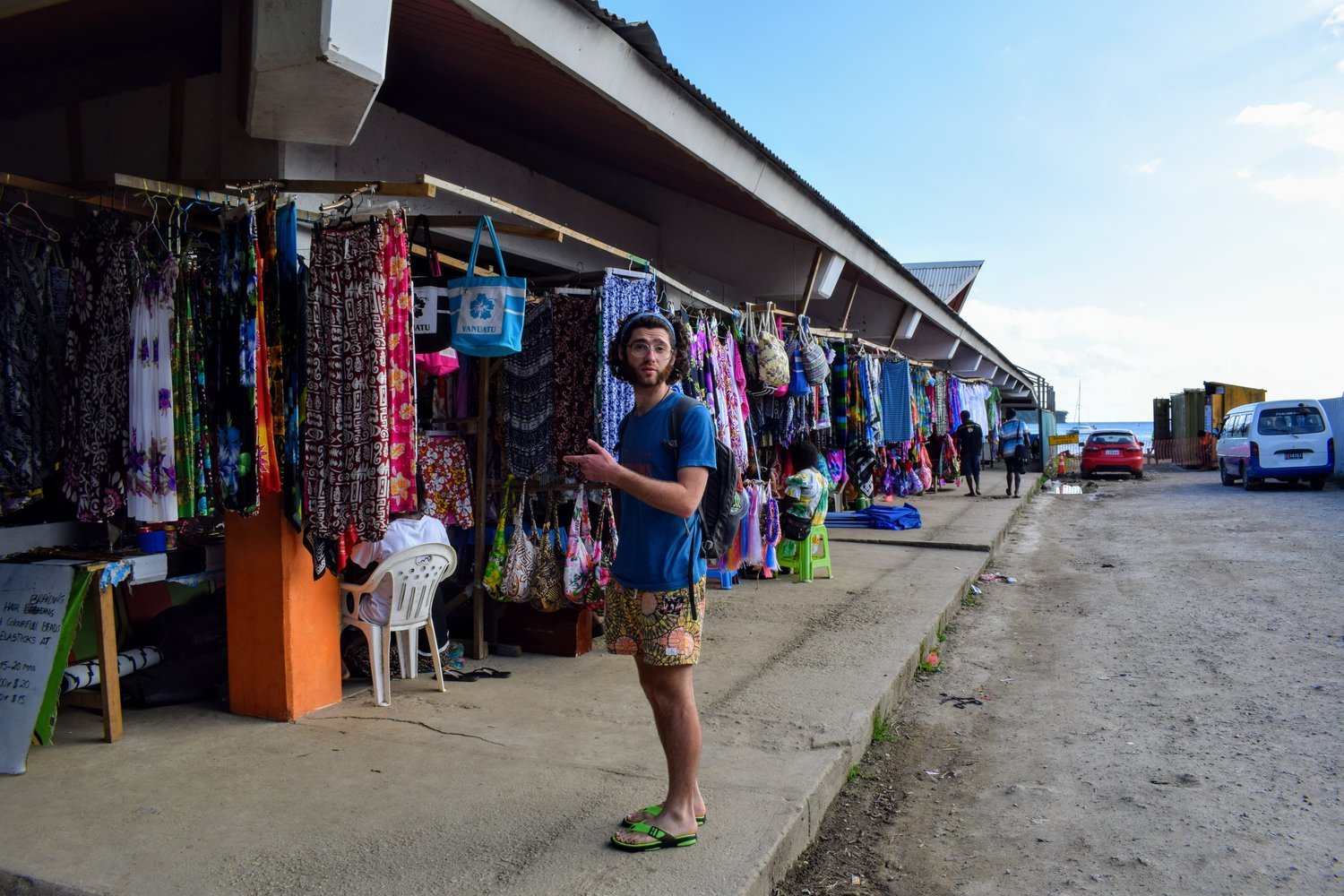
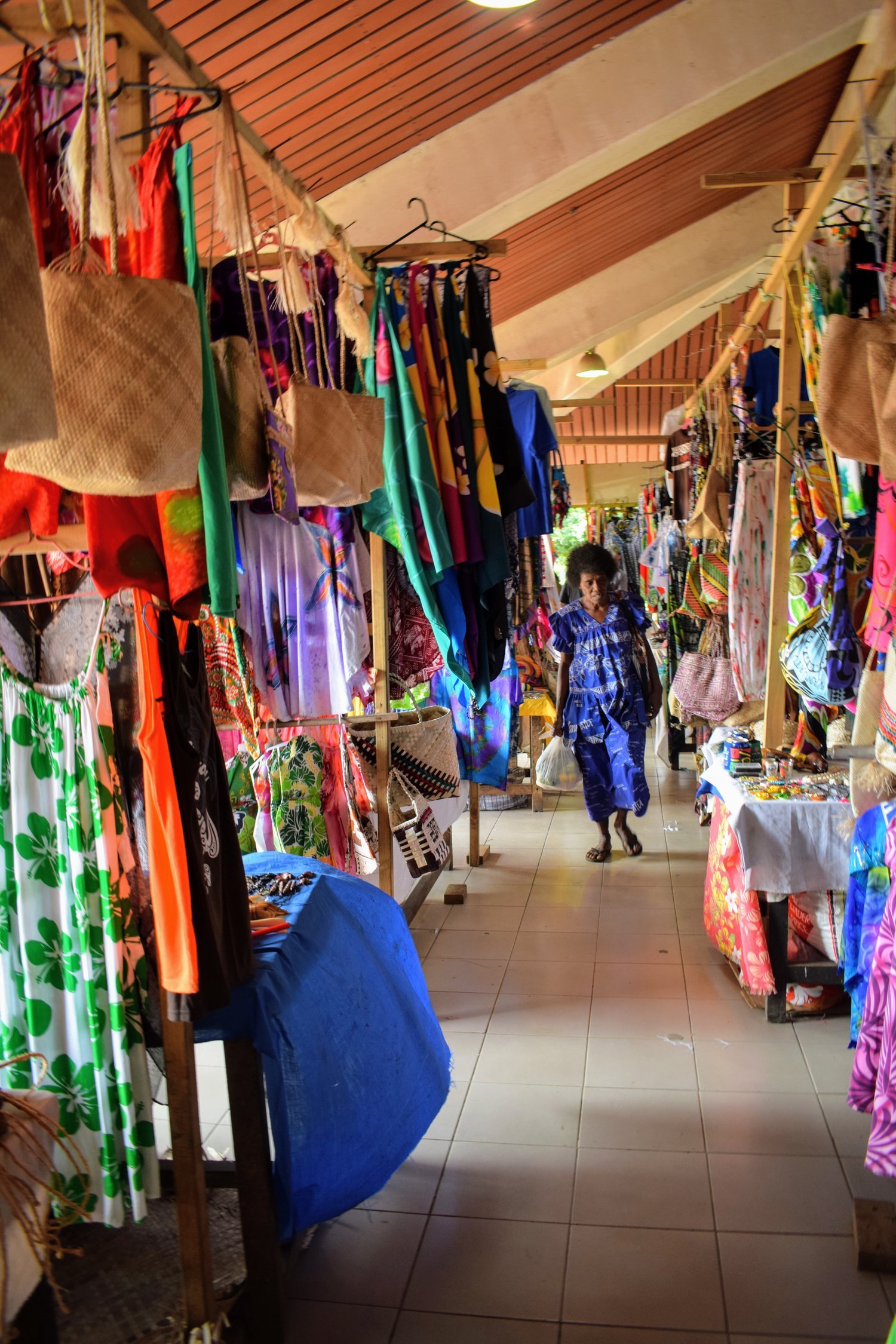
Down a souvenir alley.
The crafts and clothing portion of the market was made up of a labyrinth of small tiled alleys. Most of the vendors were selling the same things: handwoven baskets, wooden carvings, plastic trinkets that were suspiciously uniform (*cough* factory produced), and tropical-print dresses. I’d heard that it was considered more respectful to wear modest-length dresses in smaller villages in Vanuatu, so I picked up a knee-length dress to have on hand for any potential village stays. A few days before we left Vanuatu, we scoured the alleys again to look for some authentic and unique gifts for the folks back home. I couldn’t resist buying a vibrant canvas painting from a talented artist… for myself. Her bold work really caught my eye and I couldn’t resist. (Also, yes: my hair is pink in the picture on the left. CJ helped me dye it in Auckland a day or two before we left for Vanuatu – but the South Pacific quickly washed it away within a few days).
See Also: Richmond, Virginia Street Art Guide
Overall, Emmett and I went to the Port Vila Market on numerous occasions. It was not only within walking distance of our hotel, but it was the perfect place for snacks and people-watching and strange fruit-gawking. One of the last times we visited, we went in the evening. The bi-weekly cruise ship crowds had long since left town and most of the vendors were talking or singing quietly among themselves. We were on a mission to buy some fruit but ended up grabbing some skewer-roasted almonds for a pre-dinner snack. Those almonds were heavenly – tender yet flavorful, almost chewy. If only we’d discovered them sooner!

The market at around 7 PM.

A lot of vendors had a few small bottles of homemade coconut oil. It got me wishing I had access to a kitchen during our stay.
Know Before You Go – Port Vila Market
Where it’s at:
On the waterfront in downtown Port Vila near the Au Bon Marche supermarket. Click here for the Google Map. This google map link is accurate but I do not recommend relying on Google Maps around Port Vila or Efate because they were extremely inaccurate about the location of a rental car agency. Grab a map of Efate from your accommodation or a tour agency.
When to Go:
1. For groceries, go anytime: The produce portion of Port Vila Market is open all hours of the day on Monday through Friday and until noon on Saturday.
2. For souvenirs, go on a weekday before 4:30 PM or on Saturday before closing. Most souvenir/craft vendors close up shop in the evenings. Also, try to AVOID being at the market on the same day as the visitors from a cruise ship. Not only is the market packed with other tourists but some of the vendors jack up their prices a bit for those one-day visitors. While we were there in early July, Wednesdays and Saturdays were cruise days. If you really want to avoid these crowds, a quick search online will let you know when the next ships are coming into port. If you are coming to the market from a cruise, be prepared for crowding.
3. For a meal, go on a weekday around lunchtime. The hall of mini-restaurants seems to have the most going on around lunchtime, and there were also more places open for business here around noon than at any other time of day. This area is also not open past 5 PM.
What to Buy:
These are just my suggestions but if anything you should definitely buy some snacks here. I really liked the cassava and banana chips that are sold in little plastic baggies. And as I said before – you can’t miss those skewered almonds if you see them. But really, all of the produce we tried here was good as well: mandarines, papayas, bananas… Go for it!
As for souvenirs, I think it’s a good general rule to avoid the cheap plastic trinkets – you know, the I Love Vanuatu keychains and other such thingamabobs. There are a couple of local artists selling things like paintings (see the one I got above), hand-dyed clothing, and more. Something like that could be a really unique gift or souvenir. Also, a lot of the baskets at the market are beautiful but I would only buy those if Vila is your only stop in Vanuatu. There are tons of smaller local markets and/or individuals selling their own personally-made weaving throughout the island of Efate and others. Often at better prices. Plus, some islanders have their own distinct style of weaving that you can only buy there. Pretty cool.
Bring cash!
This is easy enough at Port Vila Market because there are plenty of ATMs just up the road. However, having cash is pretty much necessary to buy anything anywhere else in Vanuatu. If Vila is your first stop, this market will be a good opportunity to get into the cash-only mindset.

Destinations
Madeira Travel Guide: Top Attractions, Hidden Gems & Local Tips
Destinations
Amalfi Coast Travel Guide: A Journey for Every Type of Traveler
Travel
How to Choose the Best Fat Tire Electric Bike for Different Terrains

How to Choose the Best Fat Tire Electric Bike for Different Terrains
Choosing the best fat tire electric bike for your terrain isn’t just about looks—it’s about performance and comfort. The right e-bike depends on where you ride: smooth pavement, rocky trails, sandy beaches, or snowy roads. Each surface demands specific tires, suspension, and motor power.
This guide will walk you through how to pick the perfect fat tire e-bike for every type of terrain.
What Makes Fat Tire Electric Bikes Unique?
Fat tire electric bikes stand out because of their oversized tires—usually 4” to 5” wide—that offer better traction and stability. Whether it’s a moped-style electric bike for city cruising or a rugged off-road model, these bikes handle diverse terrains with ease.
Key Advantages:
- Excellent grip on loose or slippery surfaces
- Smoother ride on uneven terrain
- Better balance for new riders
- Support for heavier loads or cargo setups
Most fat tire e-bikes feature 500W to 1000W motors and ≥80 Nm torque, making them ideal for both hills and flat roads.
1. Best Fat Tire Electric Bike for City Streets
If you’re riding mostly on asphalt, paved trails, or urban bike lanes, comfort and efficiency matter most.
What to Look For:
- Tire Type: Semi-slick or hybrid tread (4.0”) for low rolling resistance.
- Motor Power: 500–750W hub motor for smooth acceleration.
- Battery Range: At least 48V 15Ah (40–50 miles per charge).
- Suspension: Front fork only—light and efficient for city use.
- Frame Style: Step-thru or moped-style electric bike for easy mounting.
Example setup:
A 750W fat tire commuter e-bike with 20″x4″ semi-slick tires offers great traction without draining power on smooth roads.
Pro Tip: Inflate your tires to 20–25 PSI for better efficiency and speed on pavement.
2. Best Fat Tire Electric Bike for Mountain Trails
Mountain terrain demands more power, stronger frames, and better suspension.
What to Look For:
- Motor: 750W–1000W mid-drive motor with ≥80 Nm torque for hill climbing.
- Suspension: Full suspension (front + rear) to absorb shocks.
- Tires: Deep tread 4.8” tires for traction on gravel and mud.
- Brakes: Hydraulic disc brakes (180mm rotors) for steep descents.
- Battery: 48V 20Ah or dual-battery setup for long trail rides.
- Ideal PSI: 12–18 PSI for rocky trails.
Pro Tip: A mid-drive motor keeps your center of gravity low and improves handling on tight, winding paths.
3. Best Fat Tire Electric Bike for Snowy Conditions
Snow requires traction and stability—this is where fat tire e-bikes truly shine.
What to Look For:
- Motor: 750–1000W rear hub motor (torque ≥85 Nm).
- Tires: 4.8” studded or knobby tires for maximum grip.
- Frame Material: Aluminum alloy to prevent rust.
- Battery: High-capacity 48V 17–20Ah (cold weather drains battery faster).
- Fenders: Full coverage to block slush and debris.
Pro Tip: Keep your battery warm indoors before riding—it maintains up to 15% more charge efficiency in winter.
4. Best Fat Tire Electric Bike for Beach or Sand Riding
Soft sand is tricky. You’ll need wide tires, a strong motor, and corrosion resistance.
What to Look For:
- Tires: Ultra-wide 4.5–5.0” tires with low PSI (8–12 PSI).
- Motor: 750W or 1000W rear hub motor for consistent power.
- Battery: 48V 15Ah minimum—sand adds resistance.
- Frame Coating: Anti-rust treatment or aluminum alloy frame.
- Drivetrain: Sealed components to protect from sand and salt.
Pro Tip: After beach rides, rinse your e-bike with fresh water and dry it thoroughly to avoid corrosion.
Comparison Table: Fat Tire E-Bike Terrain Guide
| Terrain Type | Ideal Tire Width | Motor Power | Suspension | Battery | Recommended PSI |
| City Streets | 4.0″ semi-slick | 500–750W | Front | 48V 15Ah | 20–25 PSI |
| Mountain Trails | 4.8″ knobby | 750–1000W | Full | 48V 20Ah+ | 12–18 PSI |
| Snow | 4.8″ studded | 750–1000W | Front | 48V 17Ah+ | 10–15 PSI |
| Beach/Sand | 4.5–5.0″ | 750–1000W | Front | 48V 15Ah+ | 8–12 PSI |
Extra Features Worth Considering
- Pedal Assist Levels: Choose models with at least 5 PAS modes for flexibility.
- Display: An LCD with real-time speed, range, and PAS data helps monitor performance.
- Lighting: Integrated LED lights improve safety for night rides.
- Accessories: Racks, baskets, or child seats can make your ride more functional.
Tips for Beginners vs. Advanced Riders
For Beginners:
- Start with a step-thru frame for easy handling.
- Use pedal assist mode to extend battery life.
- Keep tires at higher PSI for smoother roads.
For Advanced Riders:
- Go for dual batteries if you ride long distances.
- Experiment with lower PSI on dirt or snow for more grip.
- Upgrade to hydraulic brakes for precision control.
Conclusion
The best fat tire electric bike depends on where you ride most. City commuters should look for semi-slick tires and moderate power, while mountain and beach riders need wider tires, stronger motors, and solid suspension. By matching your bike’s setup to your terrain, you’ll enjoy smoother rides, longer range, and better control.

 Blog10 months ago
Blog10 months agoHow to Deal with Scabies While Traveling

 Travel10 months ago
Travel10 months agoRichmond, Virginia Street Art Guide

 Travel10 months ago
Travel10 months agoPerhentian Islands: How to Get There, What to Expect, & More

 Travel10 months ago
Travel10 months agoHow to Live in Your Car in New Zealand

 Travel10 months ago
Travel10 months agoSouvenir in Nepal: A Guide to Unique Handicrafts and Cultural Treasures

 Travel10 months ago
Travel10 months agoVegan Guide to Dining Out in Richmond, Virginia

 Food10 months ago
Food10 months agoVegetarian Food Nepal: A Journey into Flavorful Plant-Based Cuisine

 Travel7 months ago
Travel7 months agoA Local’s Guide to Sanibel Island, Florida

